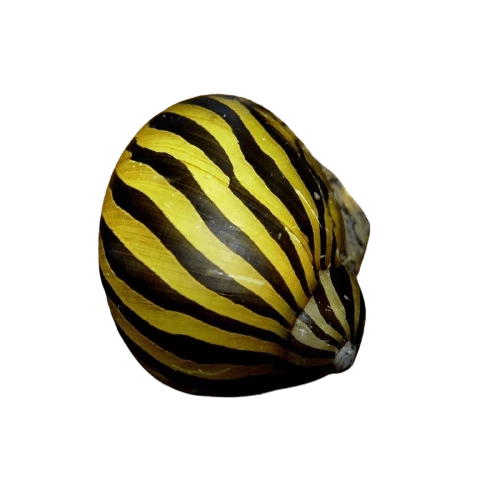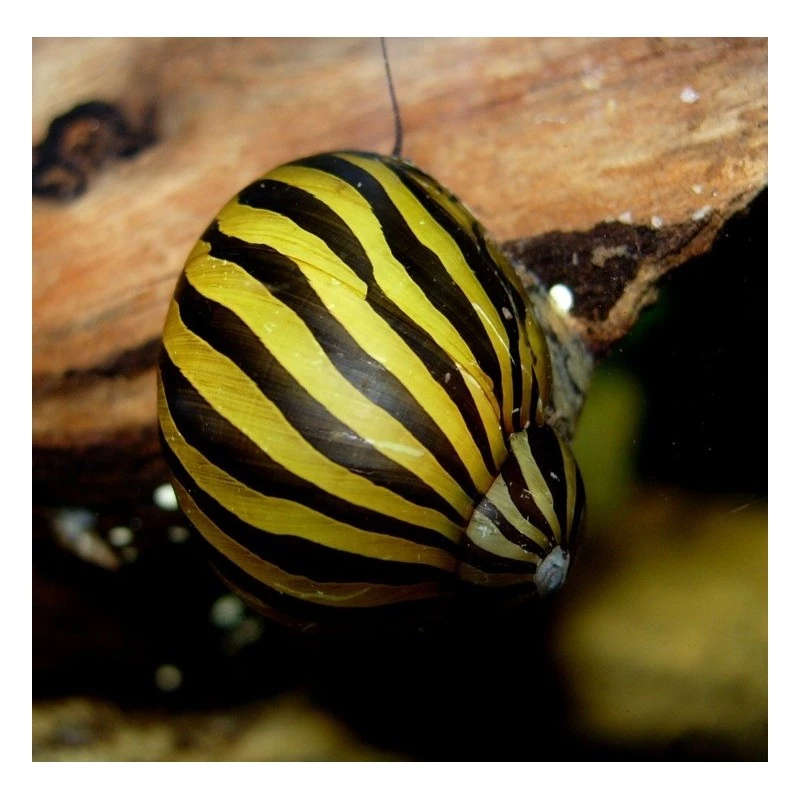Zebra Nerite Snail
R50.00
Before ordering live fish, please click to check if we can safely ship livestock to your location.
Please note that fish image is a representation of what the fish might look like as an adult.
The Zebra Nerite Snail is a highly popular freshwater snail, owing to its dazzling shell colours and patterns; and lack of reproduction in freshwater aquariums (no snail infestations!) It’s natural habitat includes South Africa, East Africa and Tanzania.
Nerite snails are one of the best options when trying to keep your tank clean, whether it’s freshwater or saltwater. They spend most of their time moving around the tank, consuming any algae in their path. Snails are ideal for beginner, as they are likely to make a few mistakes. They are very easy to care for and have few demands once you’ve added them to your tank. They will sometimes lay eggs (you need both a male and female – unlike other types of snails) in freshwater tanks, but the larvae don’t usually survive in freshwater.
These snails are from the Neritidae family, which contains over 200 species. Most of these species are from brackish, seashore waters, but a few live in rivers and streams. This means that some can be used in freshwater tanks and others in saltwater setups. Their anatomy includes a hard, coiled shell on top of a muscular “foot” which moves side to side to push the snail forwards. They also have four sensitive tentacles and a radula – a structure used to scrape food.
Those used in freshwater tanks originated from brackish waters in Eastern Africa, so they would normally live in a mixture of salty seawater and fresh river water. Saltwater species tend to be from the Pacific or Caribbean coast. Many of these snails have adapted to live in freshwater so make perfect tankmates for your freshwater aquarium; they should live for 1-2 years and grow up to 2.5 cm in size.
These peaceful snails are a great tank addition because they’re one of the best algae eaters around helping to keep tanks clean, as long as they aren’t overstocked.
Types
Different species have different colors and markings, but they share the same basic shape and structure.
- Zebra nerite snails have stripes across their shells that point towards the center of the coil. The stripes are usually black and yellow in color, but the shade can vary.
- Tiger nerite snails are similar to the zebras, except they’re a much more intense orange. The stripes are a lot more jagged too which gives each snail a slightly different look.
- Olive nerite snails are commonly kept in aquariums. Their name gives away their color, but most of them don’t have a pattern on their shell. The black line of the coil stands out against the olive color and produces a simple but attractive look.
- Horned nerite snails are a little different to the above three. They have thick black and yellow stripes, but along one stripe is a series of dark “horns”.
Behavior
Snails aren’t very active, but they’re peaceful creatures and shouldn’t cause any problems for the rest of your fish. They’ll slowly move around consuming the algae in your tank. Sometimes snails appear to have fallen over, their muscle foot is very flexible and they can usually flip themselves back over. You might want to give them a helping hand if they can’t! Snails sleep in 2-3 day cycles rather than the 24 hour cycles typical of most fish. They are thought to have around seven bursts of sleep over a 13-15 hour period and they then are able to have around 30 hours of activity.
Tank Conditions
A snail has four tentacles which are very sensitive. A fine-grained, sandy substrate reduces the risk of scratching. A fine-grained, sanded, calcium type substrate is best because it means that the snails always have a good supply of calcium, which is needed for a strong shell. Plants aren’t crucial but they’re an easy way to make a tank look natural and colorful. The snails won’t eat them either, so you can use slower growing species (such as java fern). At night, nerites are known to climb out of the water. Try to lower your water level by few centimeters to give them some room to get out of the water briefly. Snails are very good at climbing so make sure you have a tight-fitting lid for your tank so they don’t climb out.
The water needs to be free from ammonia and nitrites, nitrates should be less than 20 mg/L.
Compatibility
This snail tends to keep its vulnerable body mostly inside of its shell, as opposed to other common aquarium snails; however it is advisable to house with peaceful inhabitants such as tetras, shrimp or larger fish that will mostly ignore their presence. The amount of snails you can have in your aquarium completely depends on how many fish you’re going to keep them with. As a rough indication you can include around 1 snail per 20 litres. Just make sure they have enough algae to eat.
Feeding
Nerites aren’t fussy when it comes to food. They’re very easy to cater for and they won’t eat your plants which is an added bonus. Snails need to compensate for being slow by scavenging vegetation with their sensory tentacles and radula. They primarily feed on algae that forms on the surfaces in your tank. If you stock your tank correctly, they should be able to live off the algae. If algae isn’t forming fast enough then you should add in other foods and/or enhance algae growth by keeping your tank lights on longer. Algae wafers make good substitutes, especially since they sit on the bottom of the tank until a snail comes across them. Another option is to add green vegetables from your kitchen to the tank. Spinach and lettuce make cheap alternatives to store-bought foods and keep a snail’s diet interesting. Remember that wafers and vegetables are only needed if there’s not enough algae in your tank. If you’re having to scrape algae off the glass every now and then, the snails should be fine without being fed.
Care
A snail’s shell is a common cause for concern. Sometimes the shell’s growth can become stunted. This shouldn’t be a problem if they’re in a healthy environment since the two main causes for stunted growth are a low temperature and not eating enough. Over-eating can also be a problem for a snail’s shell. This will usually discolor it because the extra energy from the food causes the shell to grow at a faster rate. In the wild, nerite snails have dark shells because there isn’t much food. The shell stays dark as it’s growing so slowly
Snails need calcium to keep their shells strong, so a lack of calcium can cause the shell to weaken and crack. If you notice this then try adding calcium supplements (note – shrimp minerals work well), such as calcium sulfate, or use a calcium substrate.
You also need to look out for white spots on shells, as these are usually parasites that have latched on. It’s harder to tell if your snails are being affected by an internal parasite, but both forms can be fatal depending on the species of parasite.
WARNING copper is toxic to most invertebrates so keep the water in your tank free from it. Watch out for medications that contain copper, even a slight trace can be fatal to snails.
Breeding
They will breed and lay eggs, but the larvae don’t usually survive in freshwater. You can either let your snails reproduce in freshwater and move the eggs , or just start the process with snails that are already acclimatized to living in saltwater. Most snails reproduce asexually, but nerite snails are an exception. The female will produce eggs for the male to fertilize, like fish. The eggs will then be spread throughout the tank and develop into larvae over a couple of weeks. Once hatched, the young are very small, to the point where they might get sucked into the filter inlet. A sponge filter would make this virtually impossible. If breeding snails is your aim, moving them to a brackish water setup will give you the best chance of success (this is their natural habitat). If you are moving the snails from a freshwater setup you should gradually acclimate them first.
| Category | Rating |
|---|---|
| Adult Size: | 2.5 cm |
| Aquarist Experience Level: | Beginner |
| Minimum Tank Size: | 20 litres |
| Temperament: | Peaceful Community |
| Tank Level: | Bottom dweller |
| Diet: | Herbivore |
| Aquarium Hardiness: | Hardy |
| Lifespan: | 1 – 2 Years |
| Water Flow: | n/a |
| Temperature: | 22 to 26°C |
| pH: | 8.1-8.4 |
| Hardness: | harder is better |
Shipping Countries: South Africa
Shipping States: Gauteng (South Africa)
Specification: Zebra Nerite Snail
| Weight | 0.25 kg |
|---|

EXO TERRA NIGHTGLO MOONLIGHT 15W
Product Enquiry

R50.00



















There are no reviews yet.